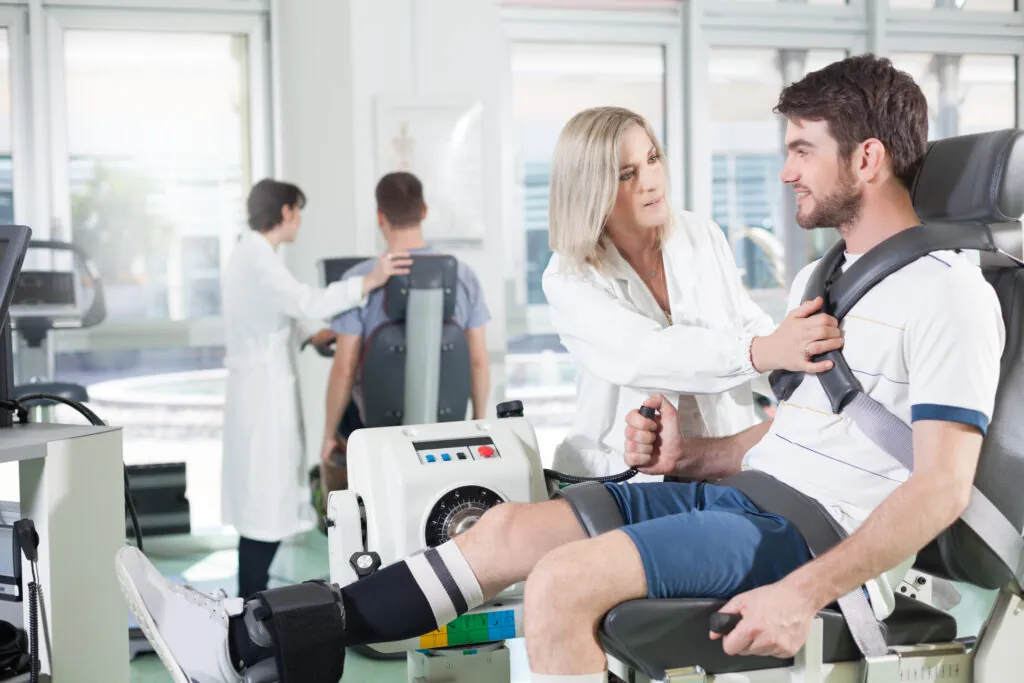By Chase Feeler, PT, DPT, NRCME
Director of Functional Testing, WorkSTEPS
Since the late 1950s, isokinetic resistance training has been a popular choice for general strength training and rehabilitation. Isokinetic exercise is defined as a type of strength training or assessment where the speed of motion remains constant while the resistance varies based on the force exerted. These features make it unique compared to traditional strength training methods, as they allow for targeted muscle strengthening and healing.
Benefits of Isokinetic Equipment
Key benefits of using isokinetic equipment include:
- Improved muscle strength through a full range of motion of contraction
- Safer rehabilitation of injured limbs by controlling speed and resistance
- Objective strength data collection
- Appropriate exercise method for individuals at all fitness levels
Because of these benefits, isokinetic exercises have been proven to have positive outcomes related to strength and rehabilitation in therapy settings, where safety and measurable progress are critical. However, applying isokinetic testing in employment settings raises very different considerations, especially for employers seeking valid and defensible testing practices.
Legal Considerations for Employment Testing
To evaluate these concerns, it’s important to understand the requirements for legally compliant employment testing criteria.
The Equal Employment Opportunity Commission (EEOC) is the government entity that investigates and defends federal laws and statutes related to workplace discrimination, including the Americans with Disabilities Amendment Act (ADAAA), Pregnant Workers Fairness Act (PWFA), and multiple other federal acts and laws related to discrimination.
The EEOC published a document called the Uniform Guidelines on Employee Selection Criteria. Within this document, the EEOC asserts that any employment testing criteria used to hire or withdraw a job offer from an individual must be “job related and consistent with business necessity.” This means tests must directly reflect the actual physical demands of the job, be validated through proper job analyses, and avoid disproportionately excluding members of protected classes. Failure to follow these requirements doesn’t just risk invalid test results—it can expose employers to costly legal challenges, reputational harm, and compliance investigations.
Challenges of Using Isokinetic Data in Employment Testing
So, what does it mean to have criteria that is “job related and consistent with business necessity?” Essentially, it means that the test criteria should be an accurate representation of the essential demands for the position being applied for.
A simple example would be if someone must lift 50 lbs. from the ground and be able to walk 10 feet and then place it on a 48-inch shelf for the job they are applying for. They could be requested to demonstrate the ability to perform this task during a pre-employment test, and if they cannot, the employer could legally withdraw their job offer.
There are other considerations, such as whether the individual has a condition which qualifies as a disability that limits their ability to perform that task. In that case, they would be entitled to interactive dialogue with the employer to see if there is a way they could be reasonably accommodated that does not create undue hardship on the employer.
When using isokinetic data to assess physical capabilities, it’s important to recognize a key limitation: these machines isolate specific body areas and measure strength in a single plane of motion. However, essential job tasks—such as lifting, pushing, pulling, climbing, crawling, and maintaining postures—require the body to move as a coordinated unit. Multiple body parts work together dynamically to complete functional tasks. Therefore, relying solely on isolated strength measurements does not accurately reflect a person’s ability to perform real-world physical job demands.
Legal Implications of Inaccurate Testing Criteria
Another issue with isokinetics related to employment testing is that isokinetics require criterion-related validity, which only occurs by collecting data from a large population of the workforce to establish “cut scores,” i.e., minimum standards for the position. This requires substantial resources and costs to complete, and most employers/job analysts skip this step, resulting in cutoff scores that are not job-specific, thus leading to potential disparate impact on protected classes (age, gender, etc.). Several court cases have highlighted these issues, finding that individuals were unjustly disqualified with employers found at fault for using inaccurate testing criteria to make employment decisions.
Cases like Stan Koch & Sons Trucking and Schuster Company1 illustrate a broader enforcement trend: the EEOC continues to challenge strength and fitness tests that lack clear, job-related validation. Beyond the legal exposure, inaccurate or non-validated testing criteria can undermine the credibility of employment programs, damage employer reputation, and expose organizations to costly turnover and re-training expenses. These cases show why employers should rely on validated, job-specific functional testing methods rather than generic strength tests that can unfairly screen out qualified workers.
Recommendations for Employers
While isokinetic resistance training offers valuable insights in rehabilitation and strength assessments, its application in employment testing is fraught with legal and practical challenges. The isolated nature of isokinetic measurements fails to capture the dynamic, multi-joint coordination required in most job tasks. Moreover, without rigorous validation and job-specific cut scores, isokinetic tests risk violating EEOC and ADA standards, potentially leading to disparate impact and costly litigation.
Employers seeking to assess physical capabilities should prioritize functional testing methods that simulate actual job demands and are validated through comprehensive job analyses. These approaches not only align with legal guidelines but also improve defensibility in court, enhance safety, and support better hiring decisions. By aligning testing protocols with legal guidelines and real-world job requirements, organizations can ensure fair, effective, and compliant hiring practices.
Ready to hire smarter and reduce risk? Contact WorkSTEPS to optimize your job descriptions and employment practices—so you can build a safer, stronger workforce.
 Chase Feeler graduated with a Bachelor of Science degree in exercise and sports sciences from Texas State University in 2007. He performed graduate work at University of Texas Medical Branch and received his Master of Physical Therapy in 2009 and his Doctor of Physical Therapy in 2010. Chase worked at a Level 1 trauma hospital for five years post-graduation before joining the WorkSTEPS team in 2015. Chase consults regularly with clinicians across the United States regarding job analysis and employment testing. Chase enjoys music, sports, entertainment, and spending time with his wife and three children.
Chase Feeler graduated with a Bachelor of Science degree in exercise and sports sciences from Texas State University in 2007. He performed graduate work at University of Texas Medical Branch and received his Master of Physical Therapy in 2009 and his Doctor of Physical Therapy in 2010. Chase worked at a Level 1 trauma hospital for five years post-graduation before joining the WorkSTEPS team in 2015. Chase consults regularly with clinicians across the United States regarding job analysis and employment testing. Chase enjoys music, sports, entertainment, and spending time with his wife and three children.
1Additional Resources:
U.S. EEOC v. Stan Koch & Sons Trucking, Inc., 557 F.Supp.3d 884 (D. Minn. 2021)




